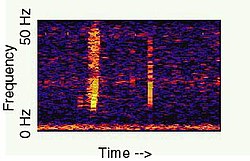Formerly unidentified sounds
NOAA
The following previously unidentified sounds have been detected by the U.S. National Oceanic and Atmospheric Administration (NOAA) using its Equatorial Pacific Ocean autonomous hydrophone array. Researchers have since posited volcanic and glacial origins for the sounds.
Upsweep

The Upsweep is an unidentified sound detected on the American NOAA's equatorial autonomous hydrophone arrays. This sound was present when the Pacific Marine Environmental Laboratory began recording its sound surveillance system, SOSUS, in August 1991. It consists of a long train of narrow-band upsweeping sounds of several seconds in duration each. The source level is high enough to be recorded throughout the Pacific.
The sound appears to be seasonal, generally reaching peaks in spring and autumn, but it is unclear whether this is due to changes in the source or seasonal changes in the propagation environment. The source can be roughly located at 54°S140°W / 54°S 140°W , between New Zealand and South America. Scientists/researchers of NOAA speculate the sound to be underwater volcanic activity. The Upsweep's level of sound (volume) has been declining since 1991, but it can still be detected on NOAA's equatorial autonomous hydrophone arrays. [2]
Whistle

This sound, dubbed the Whistle, was recorded by the eastern Pacific autonomous hydrophone deployed at 08°N110°W / 8°N 110°W on July 7, 1997 at 07:30GMT. According to NOAA, the Whistle is similar to volcanogenic sounds previously recorded in the Mariana volcanic arc of the Pacific Ocean. NOAA also stated that locating the source of an event requires at least three recording instruments, and since the Whistle was only recorded on the NW hydrophone, the sound could have traveled a great distance from its source volcano before detection. [3]
Bloop

The Bloop is an ultra-low-frequency and extremely powerful underwater sound detected by the U.S. National Oceanic and Atmospheric Administration (NOAA) in 1997. The sound is consistent with the noises generated by icequakes in large icebergs, or large icebergs scraping the ocean floor. [4]
The sound's source was roughly triangulated to a remote point in the south Pacific Ocean west of the southern tip of South America, and the sound was detected several times by the Equatorial Pacific Ocean autonomous hydrophone array. [4]
According to the NOAA description, it "rises rapidly in frequency over about one minute and was of sufficient amplitude to be heard on multiple sensors, at a range of over 5,000 km (3,100 mi)." NOAA's Christopher Fox did not believe its origin was man-made, such as a submarine or bomb. While the audio profile of Bloop does resemble that of a living creature, [5] the source was a mystery both because it was different from known sounds and because it was several times louder than the loudest recorded animal, the blue whale. [6]
The NOAA Vents Program has attributed Bloop to a large icequake. Numerous icequakes share similar spectrograms with Bloop, as well as the amplitude necessary to spot them despite ranges exceeding 5,000 km (3,100 mi). This was found during the tracking of iceberg A53a as it disintegrated near South Georgia Island in early 2008, suggesting that the iceberg(s) involved in generating the sound were most likely between Bransfield Straits and the Ross Sea, or possibly at Cape Adare in Antarctica, a well-known source of cryogenic signals. [4]
Julia

Julia is a sound recorded on March 1, 1999, by the U.S. National Oceanic and Atmospheric Administration (NOAA). NOAA said the source of the sound was most likely a large iceberg that had run aground off Antarctica. It was loud enough to be heard over the entire Equatorial Pacific Ocean autonomous hydrophone array, with a duration of about 2 minutes and 43 seconds. Due to the uncertainty of the arrival azimuth, the point of origin could only be narrowed to between Bransfield Straits and Cape Adare. [7]
Slow Down

Slow Down is a sound recorded on May 19, 1997, in the Equatorial Pacific Ocean by the U.S. National Oceanic and Atmospheric Administration. The source of the sound was most likely a large iceberg as it became grounded. [8]
The name was given because the sound slowly decreases in frequency over about seven minutes. It was recorded using an autonomous hydrophone array. [9] The sound has been picked up several times each year since 1997. [10] One of the hypotheses on the origin of the sound is moving ice in Antarctica. Sound spectrograms of vibrations caused by friction closely resemble the spectrogram of the Slow Down. This suggests the source of the sound could have been caused by the friction of a large ice sheet moving over land. [10]
Sea Train

The Sea Train is the name given to a sound recorded on March 5, 1997, on the Equatorial Pacific Ocean autonomous hydrophone array. The sound rises to a quasi-steady frequency. According to the NOAA, the origin of the sound is most likely generated by a very large iceberg grounded in the Ross Sea, near Cape Adare. [11]
Other identified sounds
- Bio-duck, a quacking-like sound produced by the Antarctic minke whale. [12] [13]
- Moodus noises, strange sounds heard in Moodus, Connecticut, later attributed to microquakes. [14]
